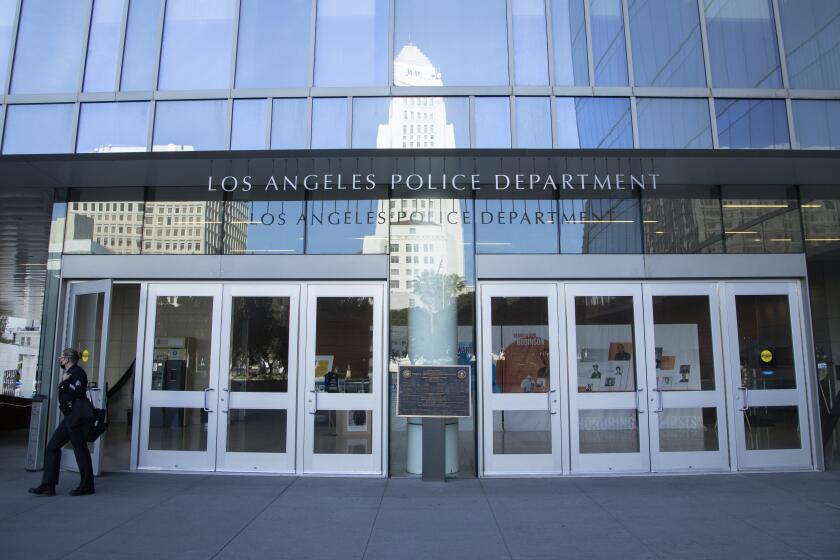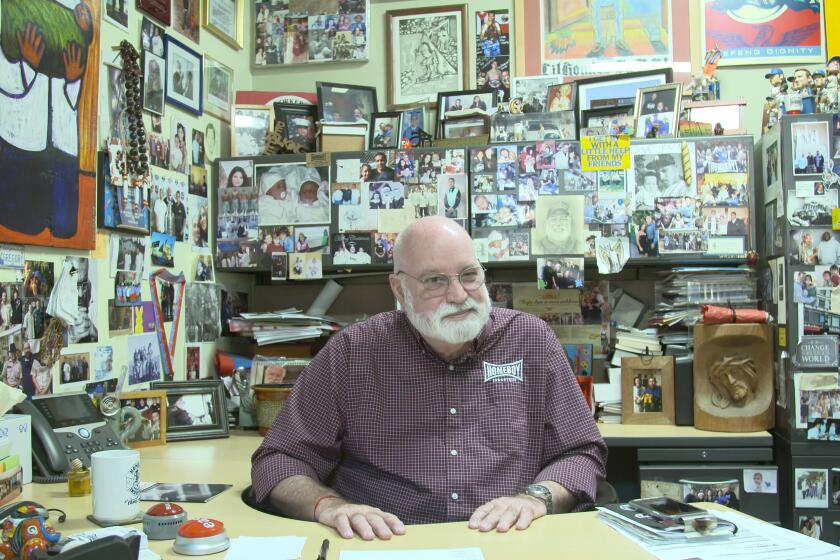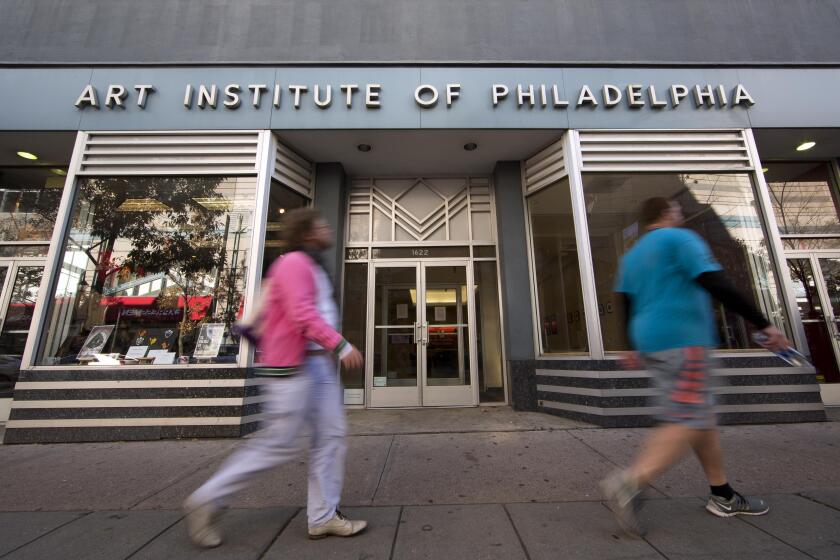Air Guard Mulls Move to Hansen Dam or Olive View
The missiles of yesteryear are long gone from the former Army Nike base on Victory Boulevard in Van Nuys, but the base is involved in modern conflicts undreamed of in the years when it waited for the Soviet bombers that never showed.
This time, it is real estate and the future of the Sepulveda Basin at stake, not the air defense of Los Angeles.
The California Air National Guard is being prodded by state Sen. Alan Robbins (D-Van Nuys) to vacate the 25-acre site it uses in the basin to make room for the homeless San Fernando Valley Fair, to which Robbins has long been political godfather and life-support system.
The Guard now uses its Sepulveda Basin base to house the 261st Combat Communications Squadron. But if the squadron moves at all--an issue that could take years to resolve--where would it go?
After a move by Robbins that held hostage the entire state construction budget of the California Air and Army National Guard, the Guard has now come up with alternative sites in the San Fernando Valley area to which it would be willing to move.
A spokeswoman for Robbins said four locations were under study--land at Hansen Dam and Van Norman Dam, the Oat Mountain California Conservation Corps camp and Olive View Medical Center. However, Maj. Steve Mensik, spokesman for National Guard headquarters in Sacramento, said Saturday that only Hansen Dam and Olive View Medical Center remain in the running, “and Hansen Dam is way out in first place.”
Not Enough Room
He said Los Angeles County authorities concluded there is not enough room for the squadron at Van Norman Dam, which holds back the waters of the Los Angeles Reservoir above Granada Hills.
The Oat Mountain CCC camp, atop a peak in the Santa Susana Mountains just north of Chatsworth, was ruled out because it is accessible only by a steep dirt road. It would be too difficult for guardsmen to reach the site “unless they all had 4-wheel-drive vehicles or we could helicopter them up there,” Mensik said.
Although Olive View, the newly rebuilt county hospital above Sylmar, has about 135 acres of unused land, a National Guard engineering survey found Hansen Dam--the flood control basin and recreational area in the foothills below Lake View Terrace--a more suitable site, Mensik said.
Robbins’ effort to replace the Air Guard with the fairground faces a formidable list of opponents.
The move out of the Sepulveda Basin has been opposed by Rep. Anthony C. Beilenson (D-Tarzana), whose district includes the basin, and by neighborhood homeowners’ groups. The homeowners argued that, in contrast with a fairground, the Air Guard is a quiet and unobtrusive neighbor. They voiced fears of traffic, crowds, noise and crime.
And the move into Hansen Dam is opposed by the Army Corps of Engineers--which owns both the Sepulveda Basin and the Hansen Dam site where Robbins wants it to move--and Rep. Howard L. Berman (D-Panorama City). Berman, whose district includes Hansen Dam, has said he wants the land reserved for recreational development.
Some Guard officers privately expressed unhappiness over the prospect of a move.
They said the Victory Boulevard site is well-located for the squadron’s unusual recruiting needs. The squadron, a “mobile telephone company,” must attract volunteers with technical and engineering backgrounds and is now conveniently close to the West Valley aerospace and computer industries. The present location is also significant in one of the squadron’s most important missions--providing communications after the major earthquake that seismologists say will inevitably cause widespread damage in the Los Angeles area.
Sources in the Army Corps of Engineers say the Guard used to grudgingly accept the possibility of a move, at least in public, only to avoid a potentially damaging fight with Robbins.
Shift in Stance
But the Guard’s active hunt for a new home appears to signal a shift in attitude.
To speed the squadron on its way, Robbins has promised to lead the drive for a new home, which would cost an estimated $5.5 million.
The Guard now appears to see the effect of Robbins’ plan not as losing an old base, but as gaining a new one.
“We’re not real popular with some people in the Legislature and it’s not often we get somebody kind of insisting on building a new base for us,” one source said. “The current base was designed as a Nike site, and while it’s usable, it would be nicer to have one that was designed for a communications squadron.
“If Robbins succeeds in building us a new base, that’s just peachy. We’ll take it. And if he doesn’t, well, that’s OK too. We’re happy enough where we are. We just want to make sure we stay in the Valley.”
Robbins helped secure the Guard’s cooperation by inserting a provision in the state budget that locked up the funds in its construction account. The provision forbade the Guard to use the funds--including those appropriated for an armory the Guard planned to build in Ukiah--until the chairman of the joint budget conference committee--Robbins himself--certified that it had “completed plans for the location of a new base” for the 261st.
Robbins, now satisfied that the Guard has done that, will no longer block the construction funds, spokesmen for the Guard and for Robbins said last week.
The dispute over the future of the Victory Boulevard site is just beginning, however.
Before the Air Guard squadron can move to Hansen Dam, approvals must come not only from Guard headquarters but from the Pentagon, the Army Corps of Engineers, the state Legislature--which would have to appropriate funds for the new base--and from Congress, which heavily subsidizes the National Guard, nominally a state force.
Moving the fair onto the site presents an additional struggle.
The fair, which lost its longtime home at Devonshire Downs this year because the owner, California State University, Northridge, has begun development there, is now looking for a site to use next summer while the hunt for a permanent fairground proceeds.
Balancing Robbins’ successful maneuvering regarding the Guard’s budget was a setback in his promotion of the fair’s interests. Gov. George Deukmejian vetoed a budget proposal that would have allocated $1.95 million to construct an exhibition building for the fair, noting that the fair has nowhere to put the building.
Another tactic has gone nowhere. Robbins submitted a proposal to the Legislature in May, asking that it request the Department of Defense to “decertify the Nike missile sites in the San Fernando Valley.”
The request was sent to committee, where it has languished ever since.
Such a declaration is needed to make the former Nike sites, including the Air Guard base on Victory Boulevard, available for other uses, Robbins said. He was told, he said, that the Pentagon had never actually renounced the possibility that the sites could be reclaimed for Nike bases.
Engineers Baffled
Robbins’ request baffled the Army Corps of Engineers, which built the Nike anti-aircraft bases in the 1950s. When Nikes became obsolete in the 1960s, as Soviet ICBMs replaced bombers, the Corps administered the closure, sale, abandonment or conversion to other uses of the unneeded bases.
A Corps of Engineers official described Robbins’ request as “like a resolution against rattlesnake nests in your neighborhood, only there never were any rattlesnake nests.”
“There’s no such thing as decertifying them,” another Army spokesman said. “Tell the senator to get his act together. The Nikes have been obsolete for years, and they’re not coming back, ever.”
The Army does have a program to “certify” former sites as free from hazardous chemicals, primarily solvents used to clean metals in the 1950s and 1960s but now categorized as dangerous pollutants, he said. “That’s probably what he should ask for.”
Robbins replied, however, that “if the sites are useless, they should be decertified, and if anyone has visions of someday putting missiles on Victory Boulevard, it’s a bad place to put them. It would unnecessarily endanger the lives of many civilians and provide no meaningful defense of the United States.”
The Soviet Union may still think of the sites as missile silos, Robbins said, “and get confused and bomb them” unless they are decertified.
Army spokesmen dismissed the idea that the Nikes could return or attract a Russian assault, and took issue with Robbins’ repeated description of the Victory Boulevard sites as missile silos.
The Nikes were comparatively small--20 feet long--anti-aircraft missiles, not offensive intercontinental weapons. They were not fired from large, cylindrical silos, such as ICBMs are but were stored in underground rooms equipped with elevators and movable roofs at ground level.
If Soviet bombers attacked (since they did not, none of the 7,000 Nike sites in the United States ever fired a shot in anger), the roof panels would open when a tracking station had the enemy planes on radar. The elevator would rise through the opening, bearing two missiles, which would be raised to a vertical position and fired. Then the elevator would descend and the roof panels would close while two more missiles were loaded.
The three firing pits at the Victory Boulevard site are rooms about 70 feet long, 50 feet wide and 15 feet deep. The movable roofs and missile elevators still work, but the pits were converted to storage and electronic-repair facilities when the Air Guard took over the site from the Army in 1972.
The site was the headquarters for four Nike batteries that ringed the Valley, part of a 16-battery network built to protect the Los Angeles area.
The Nike Ajax, which carried a conventional explosive warhead, was designed in the period immediately after World War II, and the first site in the nation was installed on Point Fermin, overlooking San Pedro, in 1954. By 1957, the Los Angeles ring was complete. In addition to the Victory Boulevard site, the Valley sector included batteries on Oat Mountain and at sites named “Magic Mountain” and “Los Pinetos” in Angeles National Forest.
The sites, built at an average cost of $2.5 million each, were usually manned by about 100 troops.
The 1,500-m.p.h., 2,400-pound Ajax model was succeeded by the 10,000-pound Nike Hercules, which carried a nuclear warhead. But as ICBMs replaced piloted bombers, the need for bomber defense dwindled.
Deactivated Sites
By 1959, the Army was turning some Nike batteries over to National Guard crews. By the early 1960s, some of the sites were being deactivated. Most had been converted to other uses or abandoned by 1970. The last sites in the nation closed in 1979.
The Corps of Engineers offered the sites first to other military users, then other federal agencies, then state and local agencies. They became everything from fire stations to colleges to parks. Those built on national forest land or parkland were often simply abandoned.
Today, it is difficult for the Corps of Engineers even to locate the former sites from its old records. (An Army spokeswoman said she once received a call “from some teen-aged boy who wanted to know where the old Nike sites were. I thought he was working on a history term paper for school or something until he told me they were great places to take a girl and park.”)
The ruins of the Magic Mountain site--not related to the amusement park of that name--are still visible in the Angeles National Forest, several miles east of the ranger station where Sand Canyon Road becomes Little Tujunga Road, said Jerry Reynolds, curator of the Santa Clarita Valley Historical society.
The site was fenced in several years ago after it was vandalized, defaced and strewn with trash, he said, and the road to the site is being allowed to decay.
The Los Pinetos site, several miles west of the ranger station, became a Los Angeles County Fire Department station, he said.
The Oat Mountain site--visible atop the Santa Susanas from much of the northwestern Valley on clear days--became a CCC camp.
Remnants still exist of an associated radar tracking station in the Santa Monica Mountains overlooking the Encino Reservoir and just west of the point where Mulholland Drive becomes a dirt road. There is a fenced-in bunker covered with graffiti and surrounded by beer bottles and garbage.
That site was given to the City of Los Angeles, which designated it the San Vicente Mountain Park. Other than demolishing some of the Army’s buildings, the city has done little to groom the “park,” said employees of the Department of Parks and Recreation.
More to Read
Start your day right
Sign up for Essential California for news, features and recommendations from the L.A. Times and beyond in your inbox six days a week.
You may occasionally receive promotional content from the Los Angeles Times.






